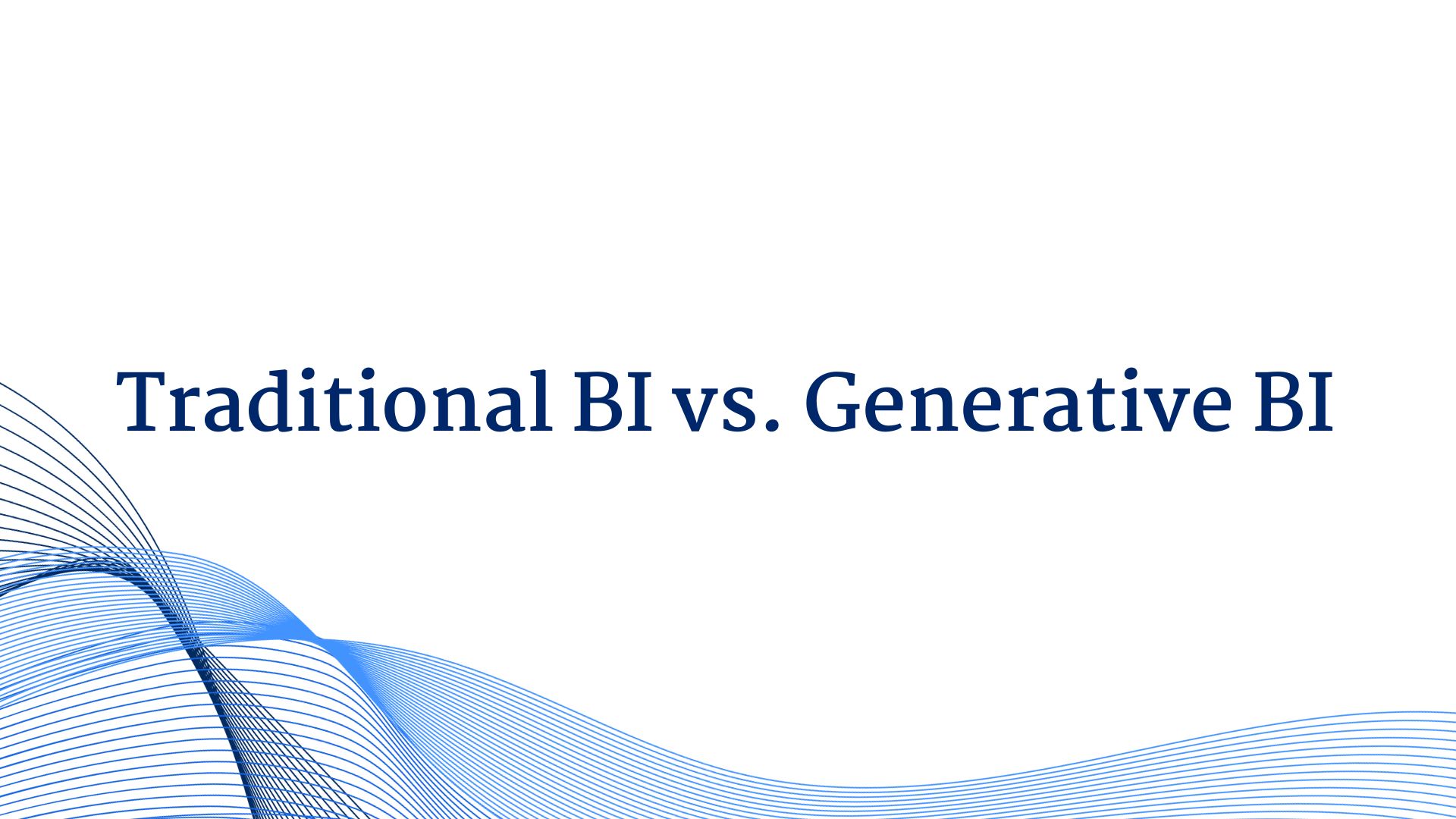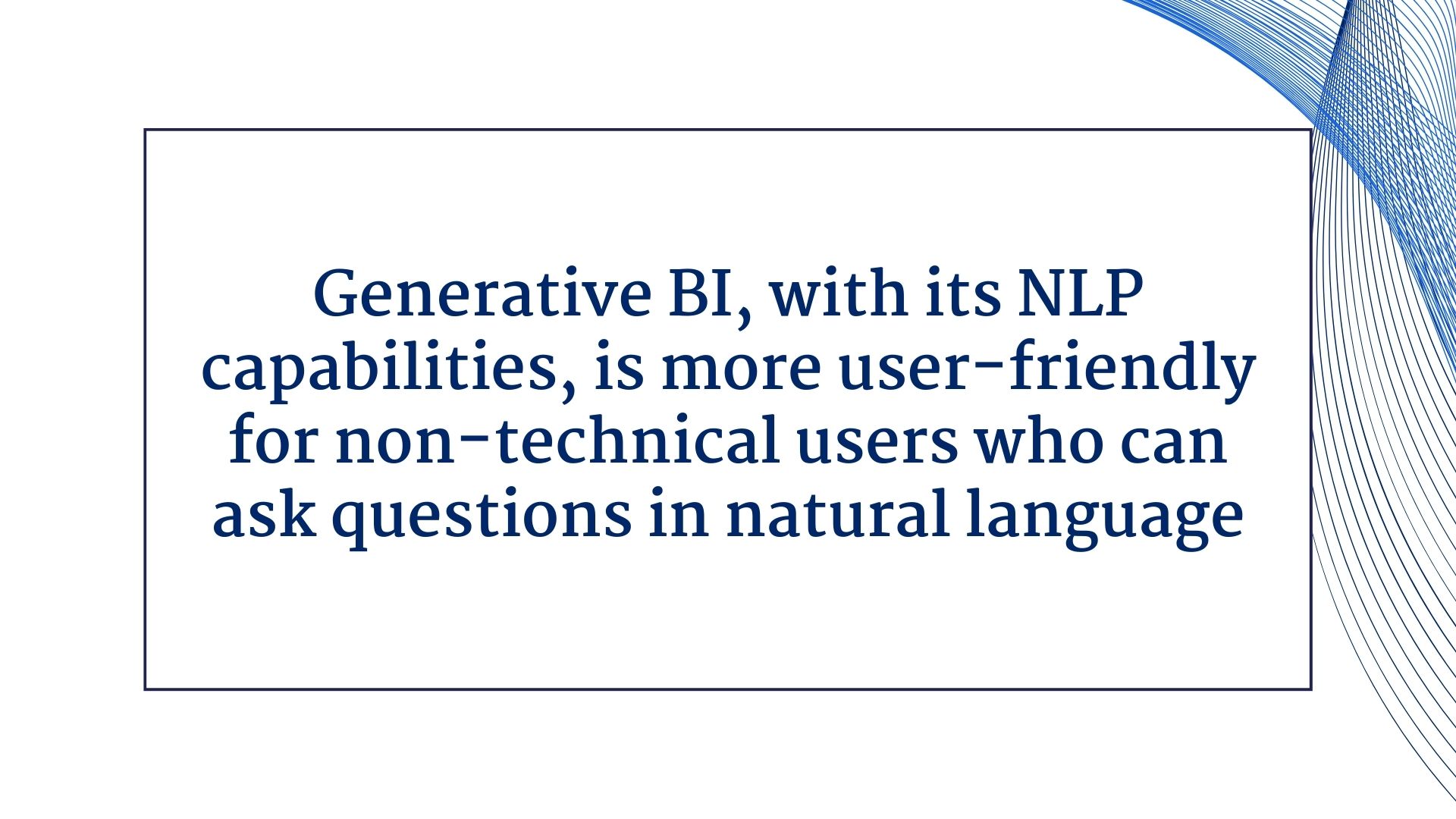- Home
- Generative BI
- Generative BI vs. Traditional ...
Table of Contents
Introduction

Business Intelligence (BI) is central to organizational decision-making. It’s about collecting, analyzing, and providing information to support informed choices. In recent years, a new approach to BI has emerged alongside more Conventional BI methodologies, called Generative BI.
In this blog we will do a comparative analysis of Generative BI and Traditional BI, shedding light on their key differences, advantages, and disadvantages.
Traditional BI
Conventional BI has been a cornerstone of Data-Driven Decision-Making for years. It includes Data Collection and Analysis using tools such as spreadsheets, databases, and Data Warehouses. Here are some of the signs of Traditional BI:
Structured Data
Traditional BI deals primarily with Structured Data, which is organized in tables and databases. This makes it suitable for well-defined metrics and KPIs.
Historical Focus
It frequently looks at past Data to identify trends and historical performance and supports retrospective analysis.
Dashboards and Reporting
Traditional BI relies on predefined dashboards and reports, which are often static and require manual updates.
Human-Centric
It relies heavily on human analysts to interpret Data, generate reports, and gain insights. This can be time-consuming and potentially biased.
Query-Based
Often, researchers and end users must conduct questionnaires to obtain desired information.
Generative BI
Gen BI is a recent development in Business Intelligence. It uses artificial intelligence and machine learning to automate and optimize Data Analytics components. Let’s explore the key characteristics of Generative BI:
Unstructured and Structured Data
Gen BI can handle both structured and unstructured Data. This flexibility is important in the age of Big Data, where a significant portion of the information is unstructured.
Real-Time or Near Real-Time Insights
Generative BI can provide real-time or near-real-time insights, allowing organizations to make decisions based on the most up-to-date information available.
Automated Reporting and Alerts
Generative BI systems can automatically generate reports and alerts when certain conditions or requirements are met, reducing the need for manual intervention.
Reduced Human Dependency
With automation of Data collection, analysis, and reporting, Gen BI reduces the need for manual data manipulation and interpretation.
Natural Language Processing (NLP)
Generative BI systems often use NLP to understand and answer natural language queries, making Data accessible to non-technical users.
Comparative Analysis

Now, let’s compare Generative BI and Conventional BI across several dimensions:
Data Handling
Traditional BI focuses on Structured Data, while Gen BI can handle both Structured and Unstructured Data.
Real-Time Insights
Traditional BI often provides historical data analysis, whereas Generative BI can offer real-time or near-real-time insights.
Automation
Generative BI significantly reduces manual intervention for Data collection, analysis, and reporting, while Conventional BI requires more human effort.
User-Friendliness
Gen BI, with its NLP capabilities, is more user-friendly for non-technical users who can ask questions in natural language. Traditional BI often requires proficiency in query language and Data manipulation.
Customization
Conventional BI often requires custom development of dashboards and reports, while GenBI can adapt and provide tailored insights on the fly.
Cost
Traditional BI tools have a higher initial cost, but they often require substantial ongoing manual labor. Generative BI has a lower initial investment but can lead to significant cost savings in the long run.
Human Bias
Traditional BI is susceptible to human bias in Data interpretation, while Generative BI aims to reduce this bias through automation.
Conclusion
The choice between Generative BI and Traditional BI depends on the specific needs and features of an organization. Conventional BI remains a reliable option for well-established metrics and reporting, while Gen BI is more suitable for organizations seeking real-time insights, automation, and advanced analytics capabilities. Many organizations take the approach hybridized on, and combine the strengths of both to ensure a comprehensive BI system.
The key takeaway is that Gen BI is a replacement for Traditional BI but rather an evolution and enhancement of the field, providing more agile and automated solutions. The future of business intelligence is likely to see the continued integration of generative BI technologies into Conventional BI systems, enabling organizations to make more accurate and faster data-driven decisions.

Apoorva is a passionate and driven individual who accidentally found her interest in Business Intelligence and Data Analysis while studying Travel and Tourism. Despite her first love for being Content Writer and Blogger, she now creates compelling content on NLP-driven decision-making and a No-Code Data Platform that influences businesses. Her commitment to making Data accessible and Democratized for everyone has led her to work with NewFangled Vision on NLP-based Conversational Driven Data Analysis.
Category
- Case Study
- CRM GenAI
- Customer Sentiment Quester
- Data Analytics
- Data Democratization
- Data Security
- Decision Enabler Platform
- Enterprise GenAI
- Excel Sheet Analytics
- Finance Modelling
- GenAI for manufacturing
- Generative AI
- Generative BI
- Log Analytics
- Media Analytics
- NewFangled
- NewFangled AI Architecture
- NewFangled VADY
- Newfangled Vision
- No-Code BI
- No-Code ETL
- PolusAI
- POS GenAI
- Real Estate Anlaytics
- Real-Time Data Analytics
- Research
- Self-Service Analytics
- Stream Analytics
- Uncategorized
- VADY

